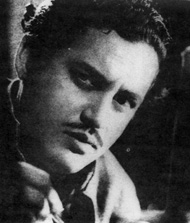| Version 3 (modified by , 13 years ago) (diff) |
|---|
Guru Dutt (1924-64)
Hindi film director and actor. Born in Bangalore as Gurudatta Padukone. Educated in Calcutta. Studied dance at Uday Shankar’s India Cultural Centre, a dance academy, in Almora (1942-4). Telephone operator in Calcutta before joining Prabhat Studio (1944) as actor (Lakhrani), then choreographer and assistant director (Hum Ek Hain, 1946).
Met Dev Anand and was part of an informal group of ex-IPTA members at Navketan, the company that produced his first film, Baazi. Set up own production house with Baaz. Introduced Waheeda Rehman in CID (1956), propelling her to stardom through his films. Made adventure films, comedies (also starring in Twelve O’Clock) and love stories. Films often referred to social issues and exploitation, partly following Chetan Anand’s version of John Huston-type realism but imbuing them with thematic layers amid complex, richly stylised imagery (courtesy of cinematographer V.K. Murthy) and exquisite songs. Made India’s first CinemaScope film, Kaagaz Ke Phool, which flopped. Refused to sign his films after that but continued as producer and actor. Sahib Bibi Aur Ghulam was credited to his co-scenarist Abrar Alvi but is attributable to Dutt.
His premature death by suicide was foreshadowed in the autobiographical Kaagaz Ke Phool. His last film, Baharen Phir Bhi Aayengi, was finished by his brother Atma Ram in 1966, with Dharmendra in the role Dutt had played. A 2nd film left unfinished, K. Asif’s Love and God, was eventually released in 1986 in a completely reshot and recast version. As producer, launched the career of his assistant Raj Khosla with CID. With the darkly romantic Pyaasa, almost certainly inspired by Saratchandra’s novel Srikanta, muted social critique suddenly veers to tragedy as Dutt launched a cycle of films that have remained India’s most spectacular achievement in melodrama. His work encapsulates with great intensity the emotional and social complexities affecting the artist when the reformism associated with Nehruite nationalism disintegrated under the pressures of industrialism and urbanisation, creating the space for Indian modernism but also generating immense social dislocation. Dutt’s work, like his life, is located on the faultline of those conflicting forces and his supreme achievement is to have succeeded, at times, in both using and modifying available aesthetic modes to represent a profoundly contradictory experience, often via a focus on his extraordinary female figures (e.g. Waheeda Rehman) who are made to represent the conflictual dynamics of history. Book-length analysis of his films by Arun Khopkar (1985).
Filmography
(* also act/ act only): 1945: Lakhrani; 1951: Baazi; 1952: Jaal; 1953: Baaz*; 1954: Aar Paar*; 1955: Mr and Mrs ’55*; 1956: Sailaab; 1957: Pyaasa*; 1958: Twelve O’Clock; 1959: Kaagaz Ke Phool*; 1960: Chaudhvin Ka Chand; 1962: Sahib Bibi Aur Ghulam; Sautela Bhai; 1963: Bahurani; Bharosa; 1964: Sanjh Aur Savera; Suhagan.
Attachments
-
guru dutt.jpg
 (21.0 KB) -
added by 13 years ago.
(21.0 KB) -
added by 13 years ago.
